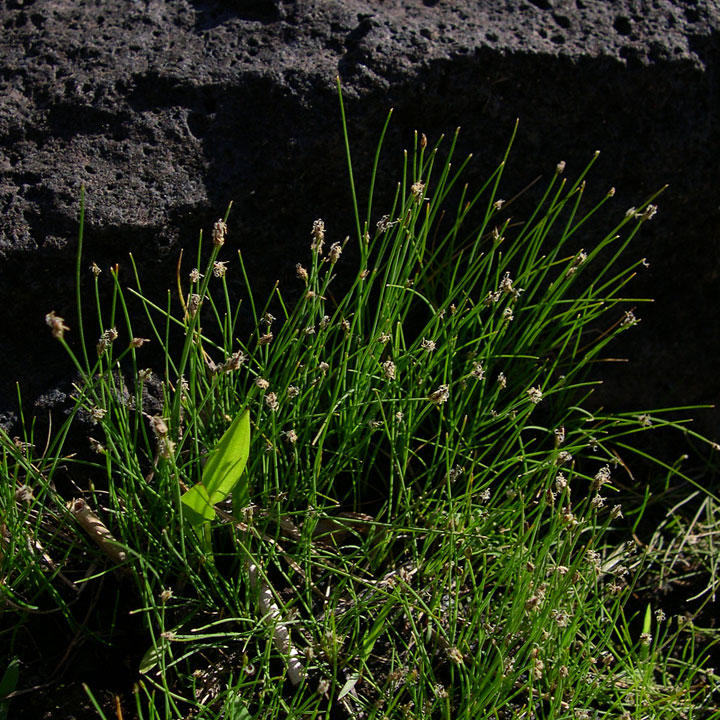Eleocharis
|
Family: Cyperaceae |
Herbs, annual or perennial, usually cespitose, often rhizomatous, sometimes stoloniferous; rhizomes rarely with terminal tubers or bulbs, horizontal and long or ascending and caudexlike. Culms sometimes solitary, terete, 3-5-angled or more, or strongly compressed in cross section, spongy with internal air cavities and incomplete transverse septa or sometimes hollow with complete transverse septa. Leaves basal, 2 per culm; ligules absent; blades absent or a mucro or awn (tooth) at apex of sheath, very rarely flattened, to 6 cm. Inflorescences terminal; spikelet 1; involucral bracts absent, rarely a proximal scale of spikelet resembling short bract. Spikelets: scales 4-500 or more, spirally or rarely distichously arranged, each subtending flower or proximal 1-2(-3) empty, stramineous (straw-brown) to medium brown or red brown or blackish brown. Flowers bisexual; perianth of (0-)3-6(-10) bristles, straight or curved, shorter than to 2 times longer than achene, retrorsely (to antrorsely) spinulose or sometimes smooth; stamens 1-3; styles linear, 2-3-fid, base (tubercle) usually persistent, usually enlarged, usually different in appearance from achene. Achenes biconvex, plano-convex, or trigonous to subterete. The name of the genus has sometimes been given as Heleocharis Lestibudois; this is now regarded as an orthographic variant of Eleocharis. Eleocharis dulcis (Burman f.) Trinius ex Henschel is sometimes cultivated for its edible tubers. Some species are weeds in rice fields, mostly extraterritorially. Almost all species are restricted to wetlands, often emergent, and sometimes submerged aquatic. No recent comprehensive worldwide taxonomic treatment of Eleocharis is available. The treatment herein is based mostly on the extensive studies by H. K. Svenson (1929, 1932, 1934, 1937, 1939, 1947, 1957), which were mostly restricted to species of North America. Classification of Eleocharis is unusually difficult because relatively few macroscopic characters are provided by the simple structure characteristic of the genus (only two leaves, basal, without blades or with only rudimentary blades, and unbranched aerial stems, each with a single terminal spikelet and without an involucral bract). Undoubtedly much evolutionary convergence has occurred in most vegetative and reproductive structures (M. S. González-E. and J. A. Tena-F. 2000; E. H. Roalson and E. A. Friar 2000). North American Eleocharis includes some extremely difficult species complexes that need taxonomic revision: (1) The E. palustris complex (species 1-7) is discussed under 1. E. palustris. (2) The E. tenuis complex (species 16-21) is discussed under 21. E. tenuis. (3) The four species (species 57-60) of 8c. Eleocharis subg. Zinserlingia that occur in North America belong to the E. quinqueflora (= E. pauciflora) complex, discussed under subg. Zinserlingia. (4) All six species of 8a2b. E. ser. Ovatae (species 42-47) constitute a complex discussed under ser. Ovatae. The supraspecific classification of Eleocharis used here is that of M. S. González-E. and P. M. Peterson (1997), which was based on a study of most species worldwide. Other recent classifications are based on more or less regional studies (H. K. Svenson 1957; T. V. Egorova 1981; I. Kukkonen 1990). A study using limited DNA data from 30 species (E. H. Roalson and E. A. Friar 2000), mostly from North America, indicates that the following supraspecific taxa are probably monophyletic: 8a2a. ser. Maculosae, 8a2b. ser. Ovatae, and 8d. subg. Limnochloa, whereas the following taxa are probably para- or polyphyletic: 8a1. sect. Eleocharis, 8a1a. ser. Eleocharis, 8a1d. ser. Tenuissimae, and 8a2. sect. Eleogenus. Users of this treatment should be aware of the following: culms that are smooth when fresh are often ridged when dry; culms of pressed specimens are often flattened and must be carefully rehydrated and sectioned to determine the original cross-section shape; culm widths given here are usually for culms pressed flat; floral scale widths are measured on flattened scales or by doubling the width measured on scales folded along the midrib; and achene length does not include the tubercle, which is often included in descriptions published elsewhere. In this treatment, I describe the tubercle (style base) after the achene in consecutive sentences to stress the separate nature of the two structures. Some species, mostly of 8a1d. Eleocharis ser. Tenuissimae, often proliferate from spikelets, often on arching or horizontal culms, especially when growing as submerged or floating aquatics. Because many such plants reproduce entirely asexually and have no normal spikelets or achenes, it is often impossible to identify them to species. The invalid name E. prolifera Torrey has sometimes been used for these plants. Species of ser. Tenuissimae in which the spikelets may be proliferous and which are easily confused with each other are E. baldwinii, E. brittonii, E. microcarpa, E. nana, E. retroflexa, and E. vivipara. Aquatic forms of at least some of those species are very hard to distinguish from Websteria confervoides (Poiret) S. S. Hooper. Other species in which the spikelets often poliferate or the culm tips root are E. pachycarpa of ser. Tenuissimae, E. melanocarpa of 8a1b. ser. Melanocarpae, and E. rostellata of 8a1c. ser. Rostellatae. When submersed, plants of E. acicularis of 8b. subg. Scirpidium and E. elongata and E. robbinsii of 8d. subg. Limnochloa may be entirely vegetative, the latter two species sometimes forming whorls of flaccid stems without spikelets.
Spikelet solitary, terminal, ovoid to linear, terete or somewhat flattened, few-many-fld; scales spirally imbricate (rarely distichous), often deciduous at maturity, the lower 1-3 empty in most spp., the others floriferous; fls perfect; stamens 1-3; style 2-3-cleft, its expanded base (tubercle) usually enlarged at maturity and persisting on the lenticular or trigonous achene; bristles typically 6, occasionally more, often reduced in number or size, or lacking; herbs of water or wet soil; stems simple, erect to prostrate, the lvs basal, reduced to bladeless sheaths. 150, cosmop. (Heleocharis) The diffuse centromere may contribute to the frequent infraspecific variation in chromosome number. Gleason, Henry A. & Cronquist, Arthur J. 1991. Manual of vascular plants of northeastern United States and adjacent Canada. lxxv + 910 pp. ©The New York Botanical Garden. All rights reserved. Used by permission. |

